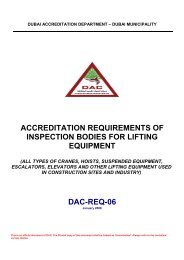Replacement of Chlorinated Solvents (CFCs, CTCs, MCFs)
Replacement of Chlorinated Solvents (CFCs, CTCs, MCFs)
Replacement of Chlorinated Solvents (CFCs, CTCs, MCFs)
You also want an ePaper? Increase the reach of your titles
YUMPU automatically turns print PDFs into web optimized ePapers that Google loves.
ﻲـــــﻨﻓ دﺎــــﺷرإ<br />
TECHNICAL GUIDELINE<br />
Number<br />
( 12)<br />
لﺎﻤﻋأ ﻲﻓ ﺔﻣﺪﺨﺘﺴﻤﻟا ( <strong>CFCs</strong>, <strong>CTCs</strong>, <strong>MCFs</strong> ) ةرﻮﻠﻜﻤﻟا تﺎﺒﻳﺬﻤﻟا لاﺪﺒﺘﺳا<br />
مﻮﺤﺸﻟا ﺔﻟازإو ﻒﻴﻈﻨﺘﻟا<br />
<strong>Replacement</strong> <strong>of</strong> <strong>Chlorinated</strong> <strong>Solvents</strong> (<strong>CFCs</strong>, <strong>CTCs</strong>, <strong>MCFs</strong>)<br />
for Degreasing and Cleaning<br />
April<br />
2011<br />
ﻢﻗر<br />
ﻞﻳﺮﺑأ<br />
ﺔﺌــــﻴﺒﻟا ةرادإ -ﻲﺌﻴﺒﻟا<br />
ﻂﻴﻄﺨﺘﻟاو تﺎﺳارﺪﻟا<br />
ﻢﺴﻗ<br />
Environmental Planning and Studies Section (EPSS)<br />
Environment Department
Introduction:<br />
The Montreal Protocol on substances that deplete the Ozone Layer that is<br />
adopted in 1987, establishes specific limits on production and consumption<br />
levels and deadlines for reduction and elimination <strong>of</strong> these substances for<br />
cleaning and degreasing activites.<br />
The solvents controlled by the Montreal Protocol are: chlor<strong>of</strong>luorocarbons (i.e.<br />
CFC-113, trichlorotrifluoroethane), carbon tetrachloride (CTC), methyl<br />
chlor<strong>of</strong>orm (MCF-only 1,1,1-trichloroethane) and hydrochlor<strong>of</strong>luorocarbons<br />
(i.e. HCFC-225, HCFC-123, HCFC 141b). These chemicals have high ozone<br />
depleting potential(ODP) which have contributed to the depletion <strong>of</strong> ozone<br />
level in the upper atmosphere. The ozone layer protects us from the harmful<br />
effects <strong>of</strong> ultraviolet(UV) radiation from the sun.<br />
The CFC-113, CTC and MCF are used extensively in general parts cleaning<br />
in a wide range <strong>of</strong> manufacturing and maintenance processes throughout the<br />
metal or plastic industry. Solvent use is integral to many production<br />
processes, removing organic compounds such as grease and oils, particulate<br />
matter and inorganic contaminants from metal or plastic surfaces and<br />
preparing parts for subsequent operations such as assembly, coating,<br />
electroplating, inspection and packing.<br />
The CFC - 113 due to its low toxicity, non-flammability and stability make it<br />
attractive for use as solvent. It is widely used in the electronics and other<br />
similar industries to clean delicate surfaces and precision instruments. Carbon<br />
tetrachloride and methyl chlor<strong>of</strong>orm is widely used in general metal part<br />
cleaning.<br />
This guideline sets out the general requirements in the replacements <strong>of</strong> ozone<br />
depleting <strong>CFCs</strong> and solvents in degreasing and cleaning industries.<br />
Guidelines:<br />
1. All substances that are classified as high ozone depleting substances such<br />
as CFC-113, 111-Trichloroethane(also known as methyl chlor<strong>of</strong>orm), and<br />
carbon tetrachloride that are used in cleaning and degreasing shall not be<br />
used from the dates stated below.<br />
Date<br />
Table 1: <strong>Chlorinated</strong> Solvent Phaseout<br />
Controlled Substances<br />
<strong>CFCs</strong> and Carbon Tetrachloride (CTC) phased<br />
January 01,2010 out<br />
January 01,2015<br />
Methyl Chlor<strong>of</strong>orm (MCF) phased out<br />
HCFC reduction by 10%<br />
January 01,2020 HCFC reduction by 35%<br />
January 01,2030 H<strong>CFCs</strong> phase out<br />
2. Any industry using the controlled substances should prepare an inventory<br />
and phase-out program in order to comply with the latest phase out
schedule as shown in Table 1. The inventory and phase out program must<br />
be submitted to Environmental Planning and Studies Section for<br />
documentation.<br />
3. Industries should examine whether there is a need to clean items at all<br />
and whether water based caustic systems can be used before considering<br />
vapour and non-vapour solvent degreasing and cleaning systems.<br />
4. Cleaner technologies now exist or are being developed that would reduce<br />
or eliminate the use <strong>of</strong> ozone depleting substances for cleaning and<br />
degreasing operations. The two main strategies are ;<br />
a. Alternative substances or materials that have low or zero ozone<br />
depleting potential including but not limited to those listed in the Table<br />
2 shall be used in cleaning and degreasing activities.<br />
b. Process changes that use different technologies for cleaning or that<br />
eliminate the need for cleaning as described below.<br />
Table 2: Alternative <strong>Solvents</strong> for Cleaning and Degreasing<br />
Fluorocarbon Compounds Non-Fluorocarbon Compounds<br />
Substances ODP Substances ODP<br />
HCFC - 225ca<br />
HCFC - 225cb<br />
HCFC-141b/HCFC123/<br />
Methanol Blend<br />
Non-Aqueous <strong>Solvents</strong><br />
0.025<br />
0.033<br />
0.08 - 0.13<br />
Isopropanol<br />
Methylene Chloride<br />
(Dichloromethane)<br />
Pentafluoropropanol(5FP)<br />
Perchloroethylene<br />
(PERC)<br />
Trichloroethylene (TCE)<br />
Hydrocholor<strong>of</strong>uorocarbons <strong>Solvents</strong> (H<strong>CFCs</strong>)<br />
To date, the HCFC-225ca and HCFC 225cb seem that the physical properties<br />
are remarkably similar to those <strong>of</strong> CFC-113 in most respects. Their<br />
ODPs have been calculated as fairly low, certainly less than 0.1,<br />
possibly even 0,05. Other possible H<strong>CFCs</strong> include HCFC-141b<br />
and HCFC-123. These have estimated ODPs <strong>of</strong> 0.08 - 0.15 and 0.02 -<br />
0.05 respectively.<br />
Fluorinated <strong>Solvents</strong><br />
Hydr<strong>of</strong>luorocarbons(HFCs) seem reasonable as fluorocarbons have a very<br />
small light reactivity and hydr<strong>of</strong>luoprocarbons mostly breakdown in the<br />
troposphere. HFCs have been proposed to dilute other solvents in order to<br />
allow blend to approach more suitable characteristics for specific<br />
cleaning applications to render it more inert or to artificially lower the ODP.<br />
The pentafluoropropanol may have useful characteristics for degreasing<br />
delicate parts.<br />
<strong>Chlorinated</strong> <strong>Solvents</strong><br />
0<br />
0<br />
0<br />
0<br />
0
Perchloethylene and trichloroethylene have been both very low ODPs,<br />
probably less than 0.01.They can be used with reasonable safety as far<br />
as the ozone layer is concerned but they are both considered as<br />
chronically toxic and probably carcinogenic. If they are used, the workers<br />
should be protected to the maximum.<br />
Chlorocarbons and Hydrocarbons<br />
<strong>Chlorinated</strong> solvents should not be considered as general substitutes for<br />
CFC-113. They are stronger solvents and have similar applications to<br />
CFC-113 for degreasing most metal parts, but they are less suitable for use<br />
on many synthetic polymers.<br />
Hydrocarbons<br />
Light hydrocarbons are all toxic and flammable. Heavier hydrocarbons with<br />
higher flash and boiling points can also be quite effecient solvents if<br />
handled correctly. Their low vapour pressure which renders them safer to<br />
use also makes drying problematic.<br />
Alcohol and other hydrocarbon derivatives<br />
Alcohols are excellent solvents for many applications, including certain<br />
defluxing operations. They do require enormous and expensive precautions to<br />
be taken before they can be used for large scale industrial cleaning. First <strong>of</strong><br />
all, they are flammable with flash points between 12° and 15°. Isopropanol is<br />
cheap, easy to obtain and not excessively toxic. A propanol/water azeotrope<br />
is suggested for some applications. Other derivatives employed for cleaning<br />
purposes include various ketones, esters and occasionally, ethers.<br />
Alcohols are smog precursor that some controls may be applied to their<br />
emissions.<br />
Hydrocarbon/surfactant blends<br />
If the solvent is blended with a surfactant or detergent, then it can be washed<br />
<strong>of</strong>f with water, which, in itself, is sufficiently volatile that it can be dried <strong>of</strong>. The<br />
most important one is that the contaminated rinse water are properly disposed<br />
<strong>of</strong>.<br />
Aqueous Systems<br />
In aqueous cleaning, water is the primary solvent. A combination <strong>of</strong> water<br />
conditioners, detergents and surfactants are added to promote better cleaning<br />
<strong>of</strong> the metal object. In addition, special additives such as builders, pH buffers,<br />
inhibitors, saponifiers, emulsifiers and deflocculants can be added to meet the<br />
desired cleaning requirements. Tap water is usually sufficient for the initial<br />
stages <strong>of</strong> aqueous cleaning followed by deionized water in the rinse stages.<br />
Advantages may include: safety; effectiveness; low cost.Disadvantages may<br />
include: cleaning difficulty in small crevices; difficulty in rinsing; difficulty in<br />
drying; requirement for high purity water; high energy consumption(heating);<br />
and waste water disposal. Ions present in the water such as calcium and<br />
magnesium can cause corrosion problems or allow deposits to form on
cleaned parts. Using deionized process water, incorporating the use <strong>of</strong><br />
thorough drying stages, and applying appropriate rust and corrosion inhibitors<br />
Semi-Aqueous Systems<br />
Semi-aqueous cleaning products have demonstrated their efficiency to<br />
remove waxes, heavy greases, tar and baked on organic materials. Generally<br />
semi-aqueous cleaners are effective at room temperature and they possess a<br />
very low evaporation rate which infers low use cost and low VOC emissions.<br />
The most common semi-aqueous cleaners include terpenes and petroleum<br />
based hydrocarbons. Terpenes are compounds derived from the natural<br />
extracts <strong>of</strong> a variety <strong>of</strong> plants, such as certain tree barks and citrus fruit skins.<br />
Generally terpenes are biodegradable and noncorrosive. These<br />
characteristics make them attractive alternative cleaners. A terpene cleaner is<br />
used typically in a cold cleaning tank. The part is immersed in the tank with<br />
agitation and then usually placed in a hot solution and dried.<br />
Several disadvantages are associated with some semi-aqueous cleaning<br />
products. The biggest concern is flammability. Several semi-aqueous<br />
cleaners have low flash points and become extremely volatile when sprayed.<br />
Health effects associated with the use <strong>of</strong> terpenes are still unclear. Several<br />
terpenes have been found to be a carcinogen among certain laboratory<br />
animals, but results are inconclusive for humans.<br />
Dry Ice Blasting<br />
This technology uses solid pellets <strong>of</strong> carbon dioxide as a blasting medium for<br />
cleaning metal parts. This process uses dry ice pellets which return to their<br />
gaseous state on impact, reduces harmful air emissions and enhances worker<br />
safety. The process relies upon thermal shock, velocity and the lateral<br />
delivery <strong>of</strong> kinetic energy. When the dry ice pellets impact the surface, the<br />
drop in surface temperature helps to pierce the contaminant or residue. Once<br />
contact is made with the base the kinetic energy acts laterally along the base<br />
surface lifting the residue away. The system's cleaning performance is<br />
optimized by controlling the pellet size, hardness, and quantity. In addition,<br />
the speed or flow can be controlled to tailor the system to a specific cleaning<br />
medium. In-process machinery, welding equipment, and turbines can now be<br />
cleaned on-line. This means less down-time for relocation, disassembly and<br />
masking<br />
The carbon dioxide pellets disintegrate upon impact and dissipate to the<br />
atmosphere. As a result, spent solvent does not need to be disposed.<br />
Hazardous wastes such as leaded paints, PCBs and asbestos can be more<br />
easily encapsulated and disposed. Because there are no liquid solvent<br />
residues left behind, the process is considered dry, making it versatile for<br />
many applications. Also, there is generally no addition to the volume <strong>of</strong> the<br />
produced waste stream for the cleaning process. For example, if solid carbon<br />
dioxide blasting is used for paint removal, the pellets sublime leaving the<br />
removed paint behind. The paint residues alone can then be collected,<br />
resulting in the smallest amount <strong>of</strong> waste. Since waste volumes are<br />
minimized, so are the costs associated with waste removal and disposal
Vacuum De-Oiling<br />
A new process on the market is vacuum de-oiling, an operation that removes<br />
surface oils from parts without using ozone-depleting or hazardous chemicals,<br />
water or detergents. Thermal and vacuum technology remove the oil residue<br />
on parts through vaporization. Once the parts have been loaded the heater<br />
and pump are actuated to warm and evacuate the unit's chamber. The oil's<br />
boiling point falls with pressure so heating it in a slight vacuum dries the part<br />
quickly. The system is not designed to clean materials that do not evaporate<br />
quickly such as a solid lubricant. In most cases parts can be cleaned through<br />
this one-step process in about 20 minutes or less. The vapors are condensed<br />
and collected for reprocessing or recycling. Hazardous waste disposal costs<br />
are reduced or eliminated in this process<br />
5. The use <strong>of</strong> solvents in cleaning and degreasing operations produce high or<br />
low emissions <strong>of</strong> volatile organic compounds (VOCs) that requires to be<br />
controlled for the safety <strong>of</strong> the workers as well as protection <strong>of</strong> the air<br />
environment. The following shall be done to minimize the emission <strong>of</strong><br />
VOCs;<br />
a. For non-vapor degreasers using volatile solvent, or solvent that is<br />
agitated, the cover should be a sliding, rolling or guillotine (bi-parting)<br />
type which can be opened and closed easily with one hand.<br />
b. For open-top vapor degreasers, the cover should be a sliding, rolling or<br />
guillotine (bi-parting) type which can be opened and closed easily<br />
without disturbing the vapor zone.<br />
c. For conveyorized degreasers, a cover shall be provided for closing <strong>of</strong>f<br />
the entrance and exit during shutdown hours.<br />
6. In order to determine the best cleaning and degreasing alternative(s), the<br />
four general areas are to be investigated;<br />
a) Governmental regulations – emission control and limit <strong>of</strong> discharges<br />
b) Technical feasibility – new process to meet required production, ease <strong>of</strong><br />
installation, operation and maintainance.<br />
c) Process economics - compare the economics <strong>of</strong> various cleaning<br />
alternatives costs associated with initial capital equipment; process operation;<br />
permit applications; and waste treatment, storage, and disposal. Process<br />
operation should include material, labor, maintenance, and utility costs<br />
d) Environmental, Health, and Safety - compatibility with regulatory trends,<br />
public perception about cleaning chemicals and associated risks, global<br />
warming potential <strong>of</strong> alternatives, energy efficiency, toxicity and worker<br />
safety, flammability, and emissions, effluents, and wastes generated
Further information is available at<br />
Environmental Planning and Studies Section<br />
℡ 04-6066809 / 6066814; Fax: 04-7033565<br />
Or<br />
Visit the Dubai Municipality Website at:<br />
www.dm.gov.ae








